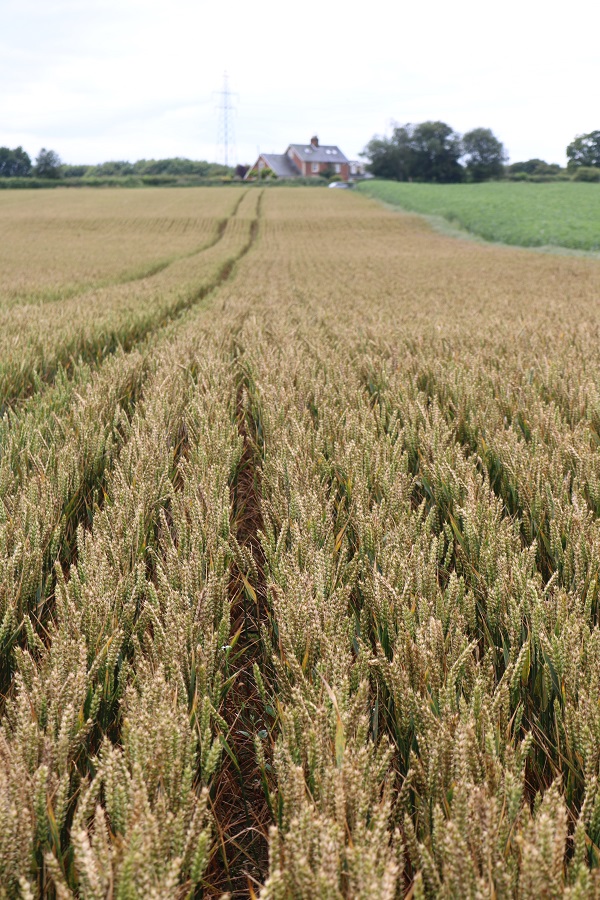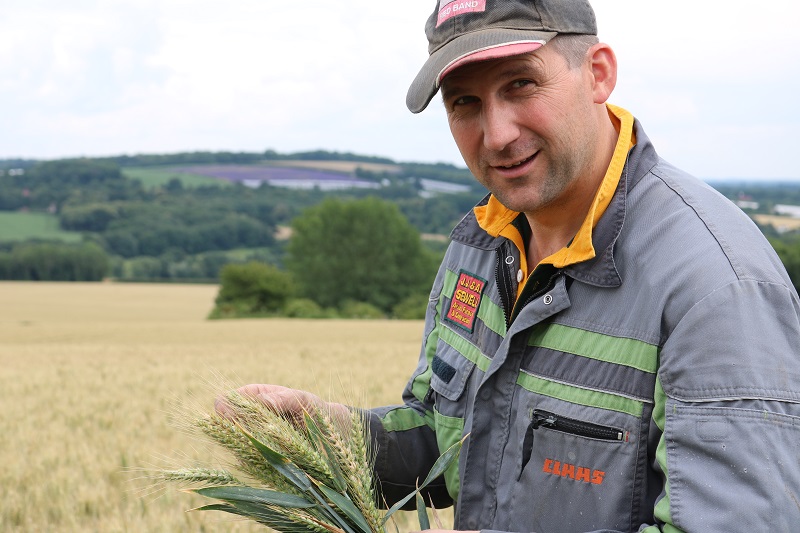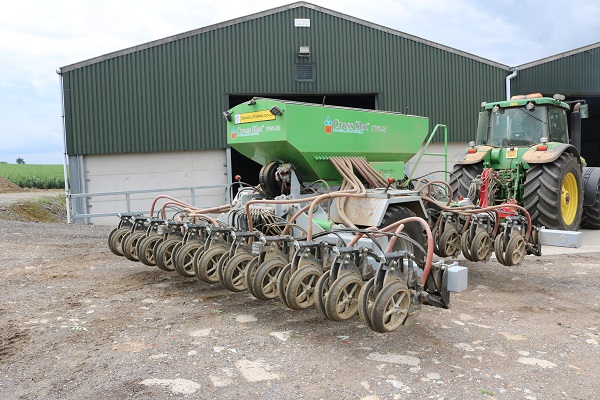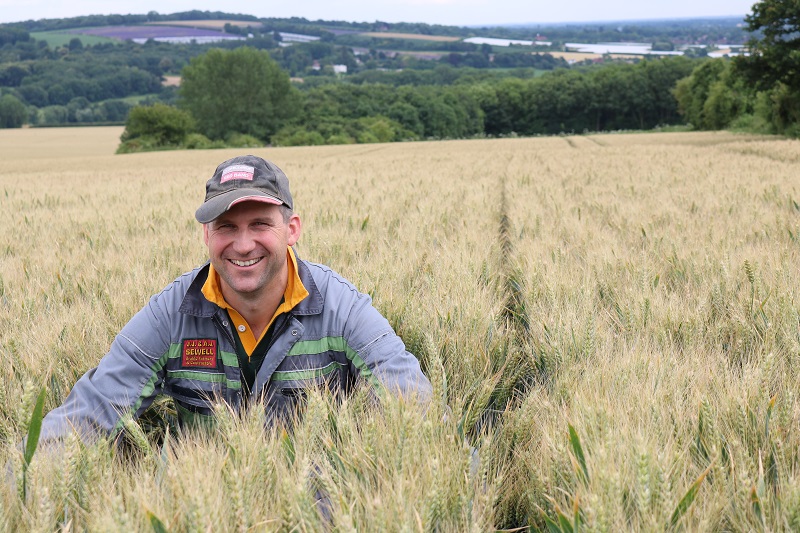Kent grower Tom Sewell’s decision to sell all the farm’s cultivation kit and invest in a one-pass, no-till system followed years of building the soil’s natural fertility. CPM visits to find out how.
To be sustainable is just standing still.
By Tom Allen-Stevens
One thing that strikes you about Tom Sewell is his relaxed, self-assured demeanour. It could have a lot to do with the state of his crops – it’s mid-July and both Skyfall and Crusoe winter wheat are looking stunning.
Or his quiet confidence could have something to do with the relatively little amount of effort it’s taken him to get his wheat to that stage. Two years ago, he sold much of the farm’s cultivation clobber and invested in a Cross Slot no-till drill, and the wheat now stands in the distinctive, regimented drill lines of the one-pass system he’s adopted. He believes this is not just more sustainable than conventional cultivations, but “regenerative”.
“To be sustainable is just standing still,” he says. “Regenerative agriculture is about enhancing your agricultural system through improving your soils. You increase soil organic matter (SOM) and biological activity, and that unlocks the land’s potential so you can improve yields and increase profit margins.”
This is the paradigm that’s now firmly adopted across the 400ha of soils near Maidstone, Kent, that vary from river

The Crusoe wheat now stands in the distinctive, regimented drill lines of the one-pass system adopted across Sewell Farms.
silt through to heavy Weald clay. Tom Sewell is a second generation farmer and runs the farm with his father, Jem, who started the business in 1984. Much of the land has been brought into an arable rotation following fruit orchards that were grubbed up as the top-fruit farms and hop-growing in the area dwindled.
“We’re blessed to have some fertile land, capable of producing good wheat yields,” he notes. These average 10t/ha, with 50% of the farm in first wheats – all Group 1 varieties. Winter oilseed rape and spring beans plug in as break crops, although oats and barley are also being introduced, and the farm is reducing its OSR area.
But what grows above the ground is just half the story for Tom Sewell. Along with independent agronomist David Jones from CCC Agronomy, who advises on crop health and protection, there’s George Hepburn of Soil Fertility Services, who takes a somewhat similar approach with the roots beneath the surface.
Team of three
“The soil is the most important asset on the farm,” explains Tom Sewell. “A lot of agronomists don’t even think about its health. So I consider that we have a team of three nurturing the crops on this farm – David tends the top growth and George looks after the rooting zone. But all three of us work together – that’s essential.”
The philosophy is about doing everything you can to allow the soil to unlock its potential. “The first thing I ask my adviser is what should I be doing, not what should I apply – that’s like going to a doctor and asking what pills to take before finding out how to stay healthy,” he says.

Tom Sewell believes that increasing soil organic matter and biological activity leads to regenerative agriculture.
Soil Fertility Services has been working with the Sewells for around 20 years. The company follows a seven-step system of soil fertility designed to maximise its biological integrity, explains George Hepburn. A detailed list of soil parameters for each field are regularly monitored and recorded to track progress. “One of the important properties we look at is cation exchange capacity (CEC),” he says.
“Clay particles are negatively charged, so all the cations, including soil nutrients, attach to these. Every soil has a different CEC, and then within that you look for a balance of cations a soil is retaining – typically you’d find 65-75% calcium and 10-15% magnesium, for example.”
The soils on the farm aren’t the best in the country, but have great potential, he notes, although with fields coming out of fruit and hops, their SOM needs to be carefully managed. “With the way the land has been farmed by the Sewells, there’s been a strong focus on building soil fertility and improving soil biology, and that’s helped its transition from ploughing to min till and now direct drilling,” says George Hepburn.
“SOM is the other essential element you look for, as the higher the SOM, the more nutrients a soil can hang onto. If there’s adequate SOM and the CEC is correctly balanced, much of what a plant needs to thrive can be accessed straight from the soil. It naturally contains tonnes of phosphate and potash – it’s just a matter of making these available.”
This detailed attention to the soil seems to have paid off – no bagged P and K have been applied for around 18 years. All straw is chopped and any nutrient requirements are made through farmyard manure or compost to

Nearly all the farm’s cultivation kit was traded in to offset the cost of the new 4.8m Cross Slot drill.
maintain a healthy SOM. Its biology is also thriving – a preliminary earthworm study carried out by Rothamsted Research in 2013 revealed relatively high numbers, particularly of the deep-burrowing earthworm species that can be extinct in conventionally tilled fields, but that plays an important role in soils.
But in recent years, Tom Sewell has developed the system much further. The epiphany moment for him came in 2012. “We had two fields side by side, one had been shallow cultivated and the other subsoiled. I walked from the shallow to the subsoiled field and sank in, which made me think ‘why do we rip up what is essentially a perfect seedbed every year?’”
At the time, the farm’s cultivations were based around a Sumo Trio min-till regime, but he was keen to move to direct drilling. He decided to research the subject carefully, and applied for a Nuffield scholarship. “Dad was a Nuffield scholar 20 years ago, so I was aware of the benefits. I wanted to see no-till systems around the world to learn what they had in common, and understand their limitations.
“What I discovered was that there isn’t any soil type where it doesn’t work, and the benefits, even in the most challenging situations, are immense. I saw no reason why it shouldn’t work here – in fact, the UK lags way behind the rest of the world in its uptake of the system.”
What he also determined was that there are four essential elements to a successful no-till system:
- Straw residues should be chopped and spread well
- Periods of bare soil or stubble should be kept to a minimum through the use of cover and catch crops
- There should be a wide and diverse rotation, ideally with at least one spring break
- You need a good, minimum-disturbance no-till drill.
Cover crops have been adopted across the farm for the past four years. An overwinter mix is established in front of the spring beans after winter wheat. Then there’s a catch crop that follows OSR in front of winter wheat.
“The idea is to keep something growing in the soil for as much time as possible,” explains Tom Sewell. “This was an essential element to successful no-till I found on all the farms I visited on my study tour. You’re encouraging the crop to do the cultivations for you in place of farm kit – roots, rather than iron, doing the work.”
He reckons it’s important to have the right mix of crops. “That’s down to the specific situation, the year, and what you’re trying to achieve. I’m part of a group of eight Kent farmers that meets three or four times a year to discuss what crops to use and how best to source them.”
He’s looking for a seed mix that will bring roots (both at depth and in the top 5cm to keep the soil friable), that will keep crop cover and also fix N. “But above all, I want to increase SOM and it must be a mix that makes financial sense. Also, if it’s followed by spring barley or oats, I don’t want a mix containing rye or oats, and if planting spring beans, I avoid vetch, phacelia and tillage radish.”
Study tour
The final part of the equation is the drill itself. “I looked at a lot of machines before settling on the Cross Slot. Initially I considered the Claydon system, but I believe that moves too much soil. We had a John Deere 750A on demo and very nearly bought one, but again it was what I learnt on my study tour that made my mind up.”
He found farmers were getting best results with drills that achieved ‘ultra low disturbance’. “You get this with a knife tine, or more commonly with a single disc.”
In New Zealand, he came across Baker No Tillage, the company that invented the Cross Slot drill, and founded by John Baker. “The drill was based on a design developed through a university project, and what impressed me most was the build quality of the machine.”
It pulls an L-shaped coulter through the soil, placing the seed on shelf beside the vertical slot. An optional L-shape on the other side places fertiliser, making the cross that gives the drill its name. “The Cross Slot places the seed into a totally clean pocket of soil and there’s excellent seed-to-soil contact. It cuts through residue but there’s very little soil disturbance.”
The change was made in summer 2014, with the drill components imported with the help of PrimeWest in Oxon and assembled on farm. Nearly all the farm’s cultivation kit was traded in to offset the cost of the new 4.8m drill – in excess of £100,000. The tractor was also upgraded to provide the 300hp of grunt he was looking for to pull the drill with ease.
“It was a considerable investment and a big change to make, but I knew it was the right move and I was determined to make it happen – failure was not an option,” says Tom Sewell.
“But importantly, we didn’t over-stretch ourselves financially and the investment was made from working capital. When Dad returned from his Nuffield Scholarship in 1992 he brought back one simple message: debt equals vulnerability, and that’s helped shape the way we run our business.”
The no-till system has been fully in place for two years, now, and the differences are already evident, says Tom Sewell. “Our running costs have reduced for no loss of yield – if anything they’ve improved – and the soil structure is more consistent. When it rains, the water runs clear out of drains and doesn’t run off the field.
“I have a wider traffic window, but then field preparation takes much less time now, so there’s plenty of spare capacity to take on extra land or work, should the opportunity arise. Equally, I now find I spend more time with my family.”
George Hepburn adds that it’s the focus on the soil that has contributed to the success. “The Sewells have spent many years building up the soil fertility and structure, and you notice the difference – you never need wellies when you visit the farm and soil never sticks to your boots. A move to no-till doesn’t suit everyone, and may not instantly bring the results you want, but Tom Sewell has earned his right to achieve those.”
How to be an on-farm innovator – Tom Sewell’s top tips
- Research your idea well. There are too many growers who take the plunge and overhaul their farm kit, perhaps following a trend, without thoroughly researching the market and assessing what’s best for their farm. Make sure you explore all options until you narrow it down to the solution that’s best.
- Stay focused. Once you’ve determined that you’ve taken the right path, have the courage of your convictions and stay with it. It’s your drive that’ll make it happen – failure is not an option.
- Make sure your team is on side. Whether that’s farm staff or family members, bring them along with your idea and keep them involved throughout. You need supportive professionals, too, and if your agronomist says it won’t work, consider changing to someone who’ll help make it happen.
- Consider cashflow. A business that’s heavily borrowed is highly vulnerable. A debt burden makes a business less adaptable to change and much of the cashflow can be tied up in interest payments. Be very wary of a plan that requires a high level of borrowing. Likewise, a progressive farming system seldom relies on subsidy payments.
- Keep some capacity. If you don’t have spare capacity in your current set up, you can’t expand and you can’t manage difficult seasons. But if you retain some leeway, you can take opportunities as they arise with just a few tweaks.
- Future proof your system. Sustainability isn’t good enough and doesn’t allow for growth, improvement and innovation. Invest time, energy and resources up front to ensure your system is truly regenerative.
Long-term view is key to success
What’s made the transition to no-till work for Tom Sewell is that it’s a considered, calculated step taken as part of a long-term plan, reckons BASF South East agronomy manager Phil Brown.
“This is no overnight decision or quick fix. It’s clear the business has been working progressively over many years to get to where it is today. What’s more, at the heart of this plan lies the farm’s biggest asset – its soil,” he notes.
“His pursuit of regenerative agriculture illustrates the qualities Tom has that help him achieve his goals. While yield and gross margin are important, they’re not the only focus. But Tom has a clear picture of what he aims to deliver, that forms the foundation for how he gets there.
“It’s also clear that the work-life balance is important to him, and he hasn’t committed himself to farming at the expense of everything else in his life,” he adds.
While some growers are changing their cultivation systems for various reasons, a whole-hearted commitment to  zero tillage probably wouldn’t suit every farm, notes Phil Brown.
zero tillage probably wouldn’t suit every farm, notes Phil Brown.
“But one of the key things that works well for many growers is detailed monitoring of what they’re doing, down to a field or sub-field level. The soil analyses Tom Sewell carries out provide a level of detail that helps him spot a potential problem and address it before it becomes an issue.”
Meanwhile, a renewed focus on the long-term health of the soil is something Phil Brown encourages for all growers. “A lot of the crop protection products, especially herbicides, BASF manufactures are soil-acting. For best efficacy, as well as for good environmental stewardship, a healthy soil with a good tilth, structure and thriving biota always delivers the best results. So we’re committed to doing what we can to help farmers retain and improve the quality of their soils,” he says.




